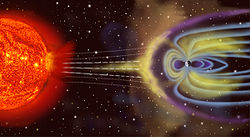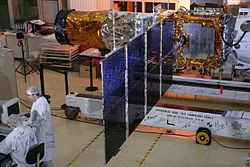describes exoplanet orbital and physical parameters. Most known extrasolar planet candidates have been discovered using indirect methods and therefore...
57 KB (6,648 words) - 16:08, 30 May 2025
Lists of planets (redirect from Lists of exoplanets)
orbited by a protoplanetary disk. There are eight planets within the Solar System; planets outside of the solar system are also known as exoplanets....
9 KB (813 words) - 17:27, 15 May 2025
Proxima Centauri b (category Exoplanets detected by radial velocity)
Proxima Centauri b is an exoplanet orbiting within the habitable zone of the red dwarf star Proxima Centauri in the constellation Centaurus. It can also...
74 KB (8,339 words) - 12:29, 24 May 2025
Orbital elements are the parameters required to uniquely identify a specific orbit. In celestial mechanics these elements are considered in two-body systems...
40 KB (5,776 words) - 17:30, 16 June 2025
Disrupted planet (redirect from Disrupted exoplanet)
In astronomy, a disrupted planet is a planet or exoplanet or, perhaps on a somewhat smaller scale, a planetary-mass object, planetesimal, moon, exomoon...
16 KB (1,509 words) - 20:00, 19 March 2025
list of the largest exoplanets so far discovered, in terms of physical size, ordered by radius. This list of extrasolar objects may and will change over...
416 KB (23,798 words) - 02:37, 19 June 2025
exoplanet or extrasolar planet is a planet outside the Solar System. The first confirmed detection of an exoplanet was in 1992 around a pulsar, and the...
157 KB (16,892 words) - 19:43, 18 June 2025
OGLE-2005-BLG-390Lb (category Exoplanets discovered in 2005)
planet's orbital eccentricity, as its orbital elements are not known, other than its orbital period). Until this discovery, no small exoplanet had been...
14 KB (1,300 words) - 19:07, 17 May 2025
Planet (redirect from Planetocentric orbit)
presents some challenges for exoplanets because the language is specific to the Solar System and the criteria of roundness and orbital zone clearance are not...
199 KB (20,937 words) - 17:02, 8 May 2025
relative position that an observed transiting exoplanet is while transiting a star, the observed physical parameters of the light curve will change. The transit...
142 KB (16,153 words) - 07:20, 13 June 2025
state of the exoplanets field in terms of their number and our understanding of their orbital and physical characteristics. EXOFAST Transit and Radial Velocity...
9 KB (916 words) - 18:14, 15 January 2025
The following is a list of exoplanet search projects. EXCEDE FINESSE Origins HabEx LUVOIR New Worlds Mission PEGASE Darwin EChO Eddington Space Interferometry...
23 KB (1,502 words) - 16:56, 26 May 2025
Habitable zone for complex life (section Exoplanets)
Wikimedia Commons has media related to Habitable zone. Exoplanet orbital and physical parameters Habitability of natural satellites – liquid water on a...
48 KB (5,264 words) - 15:57, 6 February 2025
Qatar-5 (section Physical properties)
Laughlin, Gregory (2021), "Transiting Exoplanet Monitoring Project (TEMP). VI. The Homogeneous Refinement of System Parameters for 39 Transiting Hot Jupiters...
8 KB (677 words) - 16:06, 11 June 2025
2024 YR4 (section Physical characteristics)
orbital resonances, such as the 3:1 mean-motion resonance with Jupiter's orbital period at 2.5 AU and the ν6 secular resonance with Saturn's orbital precession...
83 KB (5,495 words) - 10:22, 16 June 2025
Jupiter (redirect from Physical characteristics of Jupiter)
forming a near orbital resonance. The orbital plane of Jupiter is inclined 1.30° compared to Earth. Because the eccentricity of its orbit is 0.049, Jupiter...
172 KB (16,474 words) - 06:18, 19 June 2025
rocky exoplanet tectonics has been driven by the results of numerical modeling studies. In such models, different planetary physical parameters are manipulated...
22 KB (2,668 words) - 03:32, 11 December 2024
CoRoT (redirect from COnvection ROtation and planetary Transits - Asteroseismology and Search for Exoplanets)
host star, in order to accurately determine the stellar parameters, from which further exoplanet characteristics can be derived. Such work is done with...
131 KB (14,062 words) - 17:57, 6 June 2025
the compact orbit of Galilean satellites. Possible circumplanetary disks have also been detected around exoplanets, HD 100546 b, AS 209 b and HD 169142...
29 KB (3,360 words) - 22:56, 25 April 2025
Kepler-22b (category Transiting exoplanets)
outer shell. The only parameters of the planet's orbit that are currently available are its orbital period (about 290 days) and its inclination (approximately...
20 KB (1,861 words) - 21:14, 21 May 2025
Epsilon Indi Ab (category Exoplanets discovered in 2018)
Epsilon Indi Ab is a gas giant exoplanet orbiting the star Epsilon Indi A, about 11.9 light-years away in the constellation of Indus. The planet was confirmed...
17 KB (1,749 words) - 03:51, 19 May 2025
Circumstellar disc (section Orbital evolution)
binary occurs, and can even lead to increased binary separations. The dynamics of orbital evolution depend on the binary's parameters, such as the mass...
29 KB (3,599 words) - 02:12, 17 June 2025
Kepler-1649c (category Exoplanets discovered by the Kepler space telescope)
Kepler-1649c is an Earth-sized exoplanet, likely rocky, orbiting within the habitable zone of the red dwarf star Kepler-1649, the outermost planet of...
9 KB (882 words) - 02:13, 5 June 2025
(614689) 2020 XL5 (category Earth co-orbital asteroids)
at least several thousand years into the future based on existing orbital parameters. This would make 2020 XL5 more stable than the prototype L4 Earth...
17 KB (1,500 words) - 13:04, 20 December 2024
HD 209458 b (redirect from Osiris (exoplanet))
HD 209458 b is an exoplanet, specifically a hot Jupiter, that orbits the solar analog HD 209458 in the constellation Pegasus, some 157 light-years (48...
45 KB (4,499 words) - 22:18, 31 May 2025
Tidal locking (redirect from Spin-orbit resonance)
roughly matching the orbital speed around perihelion. Many exoplanets (especially the close-in ones) are expected to be in spin–orbit resonances higher than...
47 KB (5,088 words) - 07:37, 11 June 2025
Kepler-1647b (category Exoplanets discovered in 2016)
which showed the planet in transit. The exoplanet is a gas giant, similar in size to Jupiter, and has an orbital period of 1107 days. This is the longest...
8 KB (636 words) - 21:12, 21 May 2025
resonance). The physical principle behind orbital resonance is similar in concept to pushing a child on a swing, whereby the orbit and the swing both have...
98 KB (10,356 words) - 19:27, 6 June 2025
Ross 128 b (category Exoplanets discovered in 2017)
Ross 128 b is a confirmed Earth-sized exoplanet, likely rocky, that is orbiting near the inner edge of the habitable zone of the red dwarf star Ross 128...
14 KB (1,658 words) - 10:26, 14 June 2025
Gamma Cephei Ab (redirect from Tadmor (exoplanet))
named Tadmor /ˈtædmɔːr/, is an exoplanet approximately 45 light-years away in the constellation of Cepheus that orbits Gamma Cephei A. The planet was...
9 KB (803 words) - 16:48, 17 March 2025

























